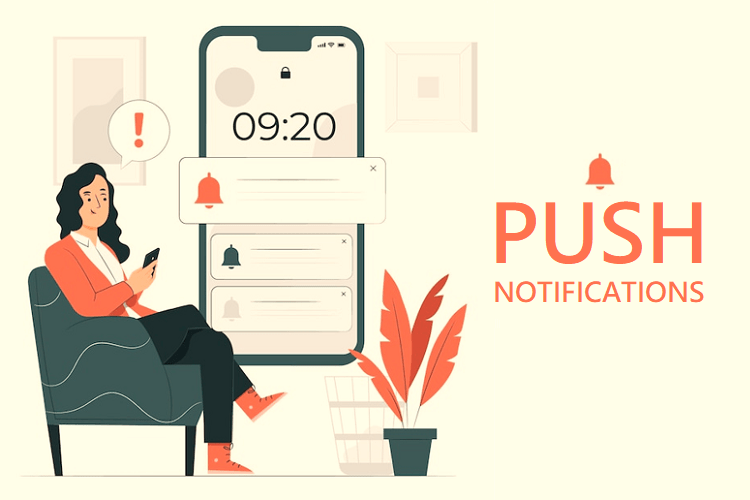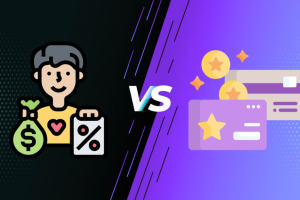Companies go to great lengths to differentiate their services and discover ways to connect with their target audience in a world of ever-evolving marketing trends. Push notification marketing is helpful in this situation.
Anybody with a mobile app must use push notifications as a vital marketing tool. It’s the finest method for interacting with your users because it sends crucial and urgent communications to their mobile devices.
Push notifications can be used for various purposes, including increasing app usage, influencing conversions, and driving engagement. There are countless potential outcomes.
But there are good and bad ways to use push notifications, which is why the experts have developed this guide. Learn more about push notifications below, including how they operate, when to use them, why you should, and how to do so efficiently.
Push Notifications – A Fundamental Breakdown

Messages that appear on the screen are known as push notifications. This form of communication is required for companies that sell goods and services online because it enables them to get in touch with clients immediately, even if they aren’t currently using an app or website.
They are instructed to check on your service and take the necessary action when an alert arises. You may either attract the attention of inactive users or re-engage individuals who have downloaded your app or visited your website but left without taking any further action by using push messages.
Contrary to somewhat dated and sometimes disregarded SMS messages and lengthy emails frequently captured by filters and sent to the spam folder, push notifications are concise, clear, and nearly challenging to miss.
They are, therefore, perfect for targeted and time-sensitive communication, such as passing special offers, sports results, information about upcoming events, health reminders, and several other things.
Businesses not delivering push notifications can boost 90-day app retention by 190%. Furthermore, it was found that 15% to 30% of iOS and Android users, respectively, did not receive any notifications for 90 days following the download. As a result, only 5% of them kept using the app after that time.
As you can see, push notifications can provide an advantage in the ongoing battle to keep users interested in and eager to use your services. Still, they might also fail if handled carelessly. As a result, this post will explain push notifications and some recommendations on using them effectively to increase revenue and improve client retention.
The Background
It’s time to step back and clarify what push notifications are. Push notifications are alerts that appear on a user’s smartphone or desktop computer through their preferred web browser. These tiny advertisements will automatically slide into view whether your app or website is open.
With Apple’s APNs (Apple Push Notification System) for iOS apps, the mobile push notification channel was established in 2009. Both types of mobile push notifications are also currently supported on Android smartphones.
An app for a mobile device transmits messages to the user’s phone screen. Users must download their mobile app and choose to receive notifications from the companies to view these warnings.
Push Notification Components
A message sent straight to a mobile device’s home screen is a push notification.
Push notifications outperform email and other channels for client communication due to their delivery. Push notifications reach a smartphone user immediately, much like an SMS text message. The next time they check their phone or tablet, this nearly assures them of seeing it.
Often, consumers automatically opt-in to these messages when they download an app. Nonetheless, the user ultimately influences how each notice is sent.
While push messages and texts have certain similarities, there are also some key distinctions you need to be aware of. Users immediately access the app after opening a push message. They do not arrive on a screen where they can see the remaining text. This necessitates keeping the message brief so that people may read it in its entirety right from the lock screen.
Push notifications can be sent without the user revealing any contact information, unlike emails and SMS. App publishers may send messages anytime, provided users have notifications turned on in their settings.
Why You Should Use Push Notifications?
You are undoubtedly well aware that push notifications are an effective marketing strategy. Many reviews have shown that this device delivers benefits that go above and beyond what is expected. Recent statistics show that 60% of mobile users elect to enable push notifications on their gadgets.
57% of respondents to a survey on the general usefulness of push notifications said they are helpful. Only approximately 30% of users approved browser-generated alerts, which reduced this number by half for online messages.
Another study suggests that push message personalization may result in even more positive results. Users of the app use it more frequently when alerts are sent to them based on their:
- Preferences (49.2%)
- Location (42%)
- “Real World” Behaviors (37%)
- In-App Behavior (32.5%)
- By Name (26.8%)
Now that you have some data on their effectiveness let’s talk about why your business should use push notifications.
1. Heightened Interest
You can see from the statistics above that push notifications are posts with significant re-engaging potential. It shouldn’t be surprising that businesses frequently integrate them in their advertising campaigns to raise customer engagement.
By delivering push notifications, you may maintain communication with customers by informing them about special offers or upcoming events. Using push alerts for breaking news is another tactic for increasing engagement.
Users receive succinct, individualized, and appealing updates encouraging them to return to an application or website and see what has changed. They can quickly use the service if they want to tap into the message, which requires no further action.
To increase the effectiveness of your push messages even further, you can employ a deep linking technique. Using this ingenious technique, you can regulate and enhance how people interact with your application.
2. Increased Client Loyalty
Users have many options regarding their digital activity because of the rapid development of mobile technology and the rising number of web and mobile services. Customers frequently download apps or visit websites, but as something new comes out, they quickly stop using them.
According to a study on the impact of push notifications on user retention, companies that carefully considered their audience and issued well-considered messages saw a 3 to 10-fold rise in retention rates. Strong brand loyalty is increased by strong retention, which shows that you value your clients. Also, it has a favorable effect on the ROI, which is essential for the business’s success.
3. Higher Rates of Conversion
Prompt messages that appear on the notifications tab have a substantial effect on conversion rates. Although this claim is especially valid for e-commerce, it also applies to the fintech industry, sports betting, and other areas of the economy. Push alerts ensure impressions because users are encouraged to reply as soon as they see them.
Online retailers or sportsbooks introduce time-limited special deals to create a sense of urgency among their customers. Because they can be issued in real-time, push notifications are an excellent method to let customers know about these promotions and allow them to take advantage of them before they end.
But, tailored push messages are the most effective. It implies that there is little possibility that your client will act if you send them an offer that is at odds with their interests. A study of the Southeast Asian e-commerce business found that push notifications that were personalized based on user variables increased conversion rates by 22%. The corporation will make more money with a higher conversion rate.
4. Audience Division
To succeed in marketing, one must first determine the preferences of their target market and then modify their plan to satisfy those wants. Thanks to web push notification systems, you may categorise your clients into different groups depending on their location, operating system, and browser. This type of information is obtained when a user agrees to receive push notifications.
You can modify the content of your message and send different notifications to different target groups by using segmentation. For example, you may advertise a campaign to iOS users or people in the United States. Your marketing initiatives may consequently result in greater customer satisfaction and more traffic.
5. Improved Customer Service
Push messaging can significantly enhance your customer service strategy. They have a greater open rate than SMS or emails and are considerably less intrusive.
Pop-ups with helpful content tailored to consumers’ wants and expectations might have a favourable impact on their customer journey. For instance, you may improve onboarding by emphasising key features and showing users the app’s displays. Also, you can point users to the appropriate FAQ site or propose potential solutions if you follow a user’s path and see they run into issues.
6. Effective Cross-Selling and Upselling Techniques
These two marketing strategies are routinely employed to increase online sales and profitability. The act of recommending to customer services or items that are more expensive and of more excellent quality than the one they have selected is known as upselling. On the other hand, cross-selling entails presenting new products that can be useful in conjunction with the ones added to the cart.
Push message upselling and cross-selling ideas could produce surprisingly successful outcomes. A prompt pop-up message offers similar but more expensive goods when a consumer is browsing your store and clicks on a particular product.
Once consumers add it to their shopping basket, a brief notification with related products appears. With these tempting deals, the customer is more inclined to purchase and spend more money, increasing the brand’s revenues.
What to Avoid While Using Push Notifications?
Push notifications offer a direct engagement channel that improves retention, one of its main advantages. Users must either have downloaded your app or have already visited your website and selected receive alerts to receive push notifications from your app. A push subscription is required for users to see your messages.
1. Introducing a Different Product
Do not send push alerts with advertisements for various products. There would be no sense in sending these communications to subscribers because the Google Play Store explicitly forbids them. Alternate the channel to market any additional services you offer that are not already included on your platforms.
2. Transmitting Worthless Messages
Any information sent to subscribers via push notifications should be relevant to them and actionable. Recall that phones receive a push notice right away, which means If it is trivial, it could be quite irritating or disturbing.
3. Asking For App Reviews
Users may choose to unsubscribe from push notifications that ask for an app rating. It is best to refrain from interrupting users in order to request positive app store reviews. This is because doing so diminishes the user experience, particularly if the notice is sent while the user isn’t actively using your app. Ensure that the information available in your alerts is actionable and beneficial to them.
Push Notifications to Improve Engagement
After this extensive analysis, the experts can affirm that push notifications are a fantastic marketing strategy for every business. A well-planned push message campaign can help you grow your company’s income by fostering direct client interactions.
Many push notification systems are on the market, so pick one of the pre-integrated options and send your customer tailored push notifications.


